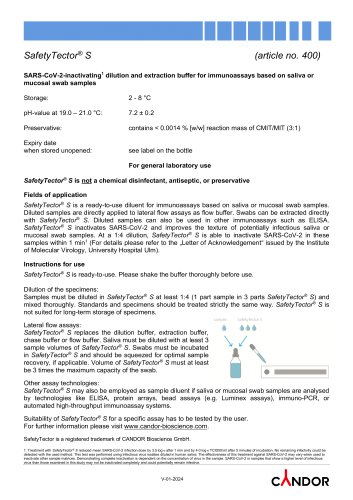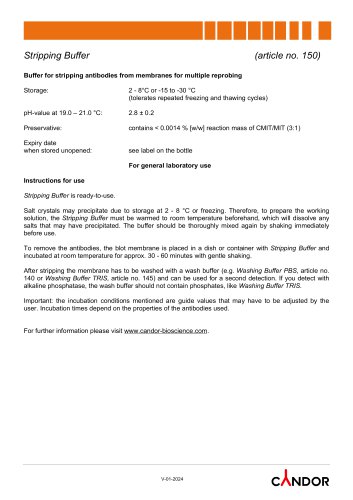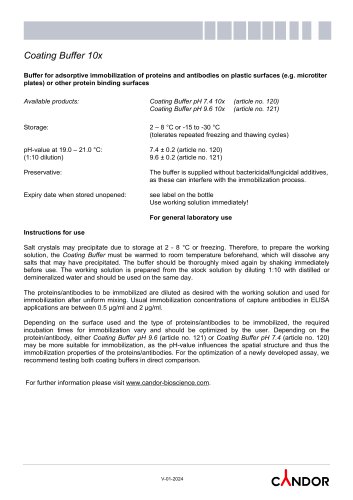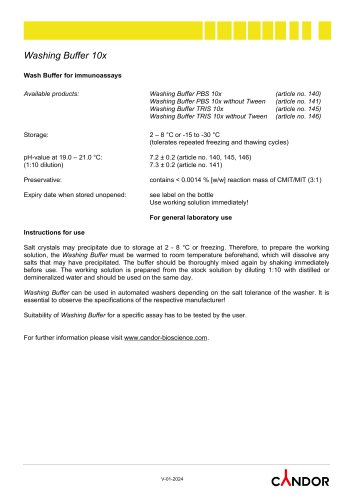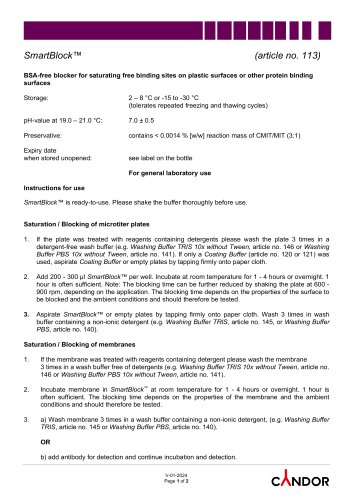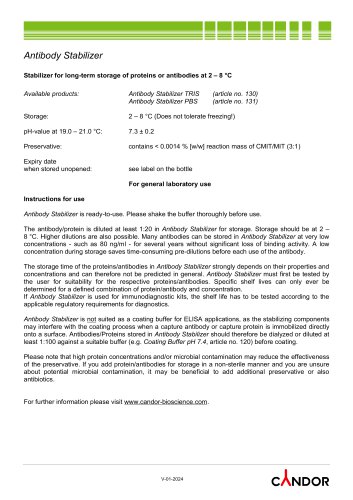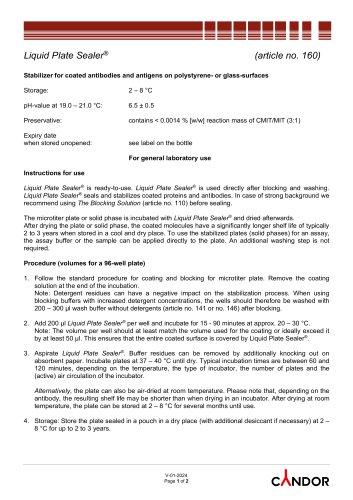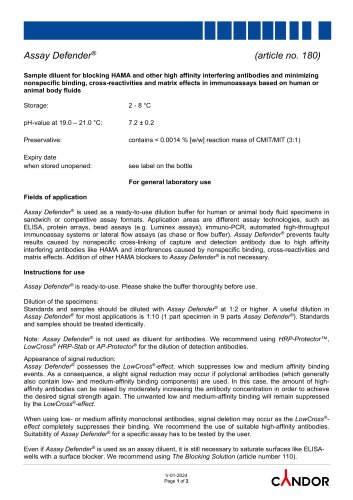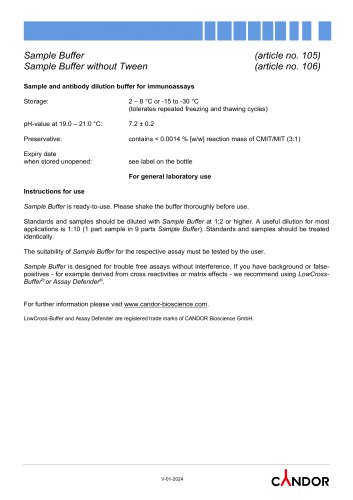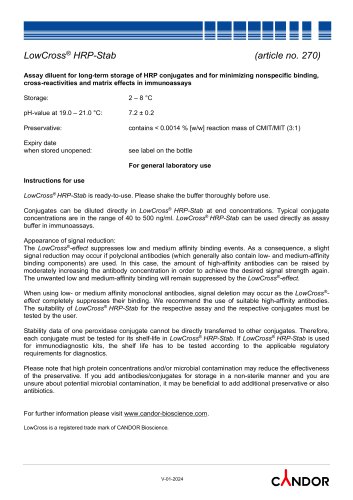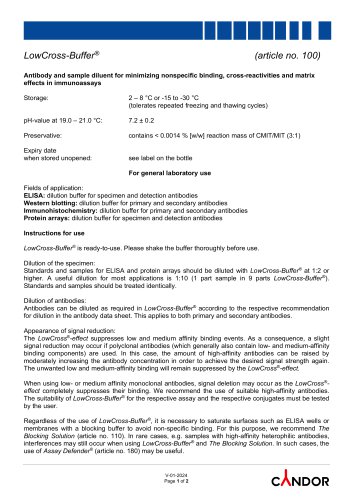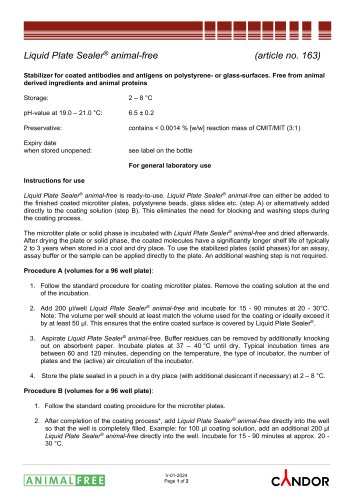 Website:
CANDOR Bioscience
Website:
CANDOR Bioscience
Catalog excerpts
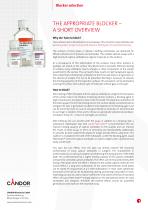
Blocker selection THE APPROPRIATE BLOCKER – A SHORT OVERVIEW Why do I have to block? Free surfaces have to be blocked in immunoassays. This is true for many methods such as ELISA, protein arrays, immuno-PCR, Western blotting or immunohistochemistry. The surfaces of ELISA plates or Western blotting membranes are optimized for efficient attachment of proteins and antibodies. This enables optimal assays with a high density of capture antibodies or capture molecules on the surfaces. As a consequence of this optimization of the surfaces, many other proteins or peptides can attach on the surface. This attachment is reversible. Without blocking of surfaces, assay antibodies, tracers, analytes or other components of the sample would bind to the surface. This can lead to false results or high background signals. Direct attachment of detection antibodies to the ELISA well leads to a signal even in the absence of analyte. This has to be prevented. Blocking is necessary to saturate free binding capacities of the respective surfaces. This saturation can be achieved by covering the surface with a dense layer of molecules without gaps in this layer. How to block? After coating of the ELISA plate with the capture antibody (or antigen), the free spaces of the surface have to be blocked. A blocking solution contains a blocking agent in high concentration. Incubation is done in the microwell. This leads to an adsorption of the blocking agent to the free binding sites on the surface. Ideally a completely dense and gap-free layer is generated. Incubation time depends on the blocking agent and can be extremely short (in case of very good blockers). Generally it’s recommended to use longer incubation times and to choose an appropriate operational procedure. Incubation times of 1 – 2 hours or overnight are common. After blocking one can proceed with the assay. In addition to a blocking step a subsequent stabilisation step with Liquid Plate Sealer® is recommended. This can improve binding capacity of capture antibodies to the analyte, and can improve the results of some assays in terms of sensitivity and reproducibility. Additionally it’s possible to store coated ELISA plates for longer periods before using them. This stabilizer is incubated in the well of the ELISA plate as with the blocking agent. Liquid Plate Sealer® covers the capture antibodies or coated antigens with a protective and easily soluble layer. This layer has two effects. First, the layer can directly improve the structural conformation of many capture antibodies or antigens. The improvement in conformation occurs during incubation and following the drying process of the ELISA plate. This is demonstrated by a higher binding capacity of the capture antibodies compared to untreated capture antibodies. This effect can be measured directly after drying of the plate, when the effect is relevant to the coated capture molecules. The second effect is a long-term stabilization of the coated biomolecules. ELISA plates can be stored for long periods at 4°C after stabilization. In most cases operational procedures in the lab can be facilitated by coating and storing many plates in stock. Stabilizing can also be used to reduce coefficients of variations of ELISAs. The positive effects of Liquid Plate Sealer® strongly depend on the biomaterials which are used (antibodies and antigens). Therefore the positive effects cannot be quantified generally but only based on the respective assay. CANDOR Bioscience GmbH Simoniusstrasse 39 88239 Wangen, Germany www.candor-bios
Open the catalog to page 1
Blocker selection THE APPROPRIATE BLOCKER – A SHORT OVERVIEW Which one is the perfect blocker? There is no perfect blocker which is well suited to every assay. A blocker has to match the respective assay and has to be selected individually for any new assay. Due to optimized plates and western blotting membranes for protein or peptide binding, protein-based blockers are more effective than other blocking solutions. In most cases synthetic blockers are less efficient than blockers based on proteins or peptides. The classic option: Blocking with BSA BSA-Block is a classic blocker based on BSA...
Open the catalog to page 2
Blocker selection THE APPROPRIATE BLOCKER – A SHORT OVERVIEW The very high blocking effectiveness compared to alternative blocking agents like BSA can be easily quantified with the measurement of the coefficient of variation. The extremely high effectiveness of The Blocking Solution is not generally necessary in every assay. We recommend using The Blocking Solution for critical applications which need an exact, reliable and reproducible quantification of analyte. The Blocking Solution is also recommended for assays with rare and precious specimens. Are there any blockers which I shouldn’t...
Open the catalog to page 3All CANDOR Bioscience catalogs and technical brochures
-
SafetyTector® S
1 Pages
-
Stripping Buffer
1 Pages
-
Coating Buffer 10x
1 Pages
-
Washing Buffer 10x
1 Pages
-
PlateBlock™
1 Pages
-
BSA-Block
1 Pages
-
SmartBlock™
2 Pages
-
ReadyTector
4 Pages
-
BUFFERS AND SOLUTIONS
20 Pages
-
The ELISA Experts
8 Pages
-
AP-Protector®
1 Pages
-
HRP-Protector™
1 Pages
-
Antibody Stabilizer
1 Pages
-
Liquid Plate Sealer®
2 Pages
-
LowCross® HRP-Stab
1 Pages
-
Assay Defender®
2 Pages
-
Sample Buffer
1 Pages
-
LowCross® HRP-Stab
1 Pages
-
LowCross-Buffer®
2 Pages


